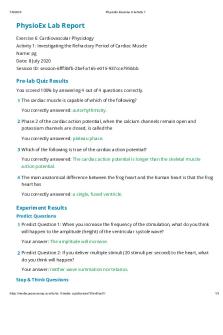Physio Ex Exercise 5 Activity 6 PDF

| Title | Physio Ex Exercise 5 Activity 6 |
|---|---|
| Author | Kaelyn Wozniak |
| Course | Human Physiology Lab |
| Institution | Indiana University of Pennsylvania |
| Pages | 3 |
| File Size | 121.7 KB |
| File Type | |
| Total Downloads | 7 |
| Total Views | 135 |
Summary
Download Physio Ex Exercise 5 Activity 6 PDF
Description
10/12/2020
PhysioEx Exercise 5 Activity 6
PhysioEx Lab Report Exercise 5: Cardiovascular Dynamics Activity 6: Studying the Effect of Stroke Volume on Pump Activity Name: Kaelyn Wozniak Date: 12 October 2020 Session ID: session-7e06535c-5af9-db2b-b2c9-0530ab85530e
Pre-lab Quiz Results You scored 100% by answering 5 out of 5 questions correctly. 1 Which of the following variables directly contributes to preload? You correctly answered: venous return. 2 Which of the following would not increase end diastolic volume? You correctly answered: dehydration. 3 Increased contractility of the heart results in all but which of the following? You correctly answered: increased end systolic volume. 4 Which of the following does not affect stroke volume? You correctly answered: All of these affect stroke volume. 5 Which of the following is not equivalent to the others? You correctly answered: end diastolic volume.
Experiment Results Predict Question 1 Predict Question: If the pump rate is analogous to the heart rate, what do you think will happen to the rate when you increase the stroke volume? Your answer: The pump rate will decrease to maintain cardiac output. Stop & Think Questions 1 Why did changing the ending pump volume (ESV) automatically change the stroke volume? You correctly answered: The heart intrinsically alters stroke volume to accommodate changes in preload. i https://media.pearsoncmg.com/bc/bc 0media ap/physioex/10/ex5/act6/
1/3
10/12/2020
PhysioEx Exercise 5 Activity 6
2 The flow has stayed constant with each trial because You correctly answered: cardiac output is equivalent to blood flow. 3 How does the heart provide for an increase in stroke volume? You correctly answered: by increasing contractility. Experiment Data Flow (ml/min)
Rad. L (mm)
Rad. R (mm)
Str. V (ml)
Rate (strokes /min)
Press. L (mmHg)
Press. Dif. R (mm Hg)
5086.8
3.0
3.0
10
508.7
40
40
5086.8
3.0
3.0
20
254.3
40
40
5086.8
3.0
3.0
30
169.6
40
40
5086.8
3.0
3.0
40
127.2
40
40
5086.8
3.0
3.0
50
101.7
40
40
5086.8
3.0
3.0
60
84.8
40
40
5086.8
3.0
3.0
80
63.6
40
40
5086.8
3.0
3.0
100
50.9
40
40
Post-lab Quiz Results You scored 100% by answering 4 out of 4 questions correctly. 1 What do you think would happen when stroke volume is decreased? You correctly answered: Pump rate would increase. 2 Why might an athlete's resting heart rate be lower than that of the average person? https://media.pearsoncmg.com/bc/bc 0media ap/physioex/10/ex5/act6/
i 2/3
10/12/2020
PhysioEx Exercise 5 Activity 6
You correctly answered: Stroke volume and contractility have increased. 3 In this activity, which of the following stayed constant? You correctly answered: flow rate. 4 Which of the following is true? You correctly answered: ESV = EDV - SV.
Review Sheet Results 1 Describe the Frank-Starling law of the heart. Your answer: When the more than normal volume is returned to the heart buy venous system the heart will stretch resulting in a more forceful contraction of the ventricles. 2 Explain what happened to the pump rate when you increased the stroke volume? Why do you think this occurred? How well did the results compare with your prediction? Your answer: When the stroke volume increased the pump rate decreased because of maintaining cardiac output. 3 Describe how the heart alters stroke volume. Your answer: Changing contractility. 4 Describe the intrinsic factors that control stroke volume. Your answer: Stroke volume can be controlled by contractility and preload. Contractility is the strength of the cardiac muscle contraction and its ability to generate force. Preload is the degree to which the ventricles are stretched by the EDV.
i https://media.pearsoncmg.com/bc/bc 0media ap/physioex/10/ex5/act6/
3/3...
Similar Free PDFs

Physio Ex Exercise 5 Activity 6
- 3 Pages

Physio Ex Exercise 6 Activity 5
- 4 Pages

Physio Ex Exercise 5 Activity 6
- 3 Pages

Physio Ex Exercise 5 Activity 6
- 3 Pages

Physio Ex Exercise 6 Activity 5
- 4 Pages

Physio Ex Exercise 6 Activity 5
- 4 Pages

Physio Ex Exercise 5 Activity 5
- 3 Pages

Physio Ex Exercise 5 Activity 5
- 2 Pages

Physio Ex Exercise 5 Activity 5
- 3 Pages

Physio Ex Exercise 5 Activity 5
- 3 Pages

Physio Ex Exercise 6 Activity 1
- 3 Pages

Physio Ex Exercise 6 Activity 4
- 5 Pages

Physio Ex Exercise 6 Activity 4
- 5 Pages

Physio Ex Exercise 6 Activity 1
- 3 Pages

Physio Ex Exercise 6 Activity 3
- 3 Pages

Physio Ex Exercise 6 Activity 3
- 3 Pages
Popular Institutions
- Tinajero National High School - Annex
- Politeknik Caltex Riau
- Yokohama City University
- SGT University
- University of Al-Qadisiyah
- Divine Word College of Vigan
- Techniek College Rotterdam
- Universidade de Santiago
- Universiti Teknologi MARA Cawangan Johor Kampus Pasir Gudang
- Poltekkes Kemenkes Yogyakarta
- Baguio City National High School
- Colegio san marcos
- preparatoria uno
- Centro de Bachillerato Tecnológico Industrial y de Servicios No. 107
- Dalian Maritime University
- Quang Trung Secondary School
- Colegio Tecnológico en Informática
- Corporación Regional de Educación Superior
- Grupo CEDVA
- Dar Al Uloom University
- Centro de Estudios Preuniversitarios de la Universidad Nacional de Ingeniería
- 上智大学
- Aakash International School, Nuna Majara
- San Felipe Neri Catholic School
- Kang Chiao International School - New Taipei City
- Misamis Occidental National High School
- Institución Educativa Escuela Normal Juan Ladrilleros
- Kolehiyo ng Pantukan
- Batanes State College
- Instituto Continental
- Sekolah Menengah Kejuruan Kesehatan Kaltara (Tarakan)
- Colegio de La Inmaculada Concepcion - Cebu